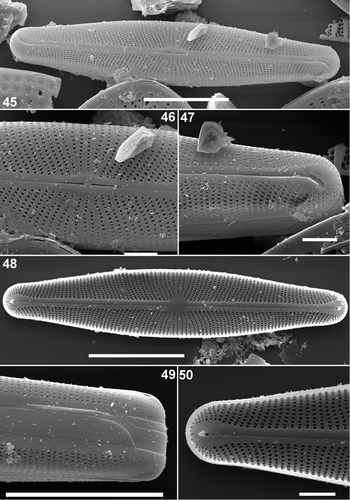Figures & data
Figs 1–16. Light micrographs of Envekadea (Navicula) hedinii. . Valve views of specimens from Lake Vrana (Croatia). . Girdle view of specimen from Lake Vrana (Cr.). . Valve views of the type population from Mapiek Köll (eastern Turkestan). . Valve view of specimen (Croatian population) showing the chloroplast structure. Scale bars: 10 µm.

Figs 17–19. Light micrographs of valve views of Envekadea (Navicula) pseudocrassirostris from Eleusis (Athens, Greece). Scale bar: 10 µm.

Figs 20–22. Transmission electron micrographs of Envekadea (Navicula) hedinii from Lake Vrana (Croatia). . Entire valve showing the square to polygonal shape of the areolae when the external hymenes have been removed. . Detail of the stria structure with the hymenes covering the areolae. . Detail of the hymenes showing their porous structure. Scale bars: 10 µm (), 1 µm () and 0.5 µm ().

Figs 23–27. Scanning electron micrographs of external views of Envekadea (Navicula) hedinii from Lake Vrana (Croatia). . Presence of the hymenes covering the external areola openings. . An eroded valve showing the raphe path with the fissures deflected into opposite directions and the typical areola structure. . Detail of the terminal raphe fissure. Note the almost straight course of the raphe branch and the irregular areola structure. . Detail of the delta-shaped central raphe pores. . A tilted valve showing the stria structure at the valve face/mantle junction. Scale bars: 10 µm () and 1 µm ().
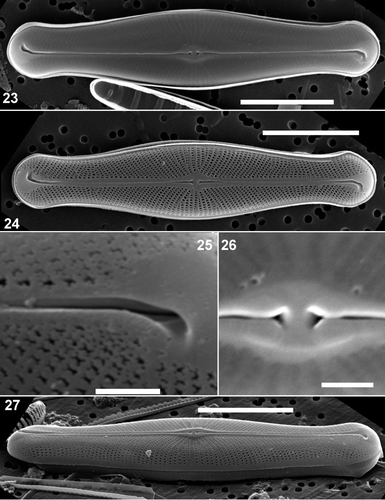
Figs 28–33. Scanning electron micrographs of valve and girdle views of Envekadea (Navicula) hedinii from Lake Vrana (Croatia). . Detail of the external valve apex with the wedge-shaped hyaline area and the clearly deflected terminal raphe fissure. . External detail of the irregularly shaped areolae near the valve apex. . Internal view of an entire valve with a partly detached valvocopula lying in the valve. . Detail of the external valve apex showing the girdle. . Detail of the valvocopula in , showing the lack of perforations and the undulated pars interior. . End of a frustule showing girdle bands and valve apices. Scale bars: 10 µm () and 1 µm ().
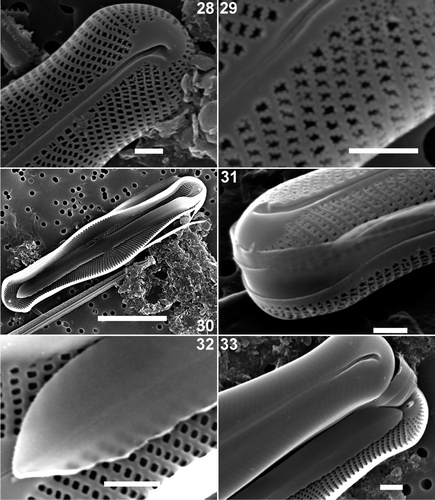
Figs 34–38. Scanning electron micrographs of internal views of Envekadea (Navicula) hedinii from Lake Vrana (Croatia). . Entire valve. . Detail of the central part of the valve with the raised internal nodule. Note the raised rims between the striae and the round shape of the areolae. . Detail of the central raphe endings. Note the slightly deflected ends. . Detail of the valve apex with the typical, very simple helictoglossa. . Detail of the valve apex with the typical, tunnel-like helictoglossa. Scale bars: 10 µm () and 1 µm ().
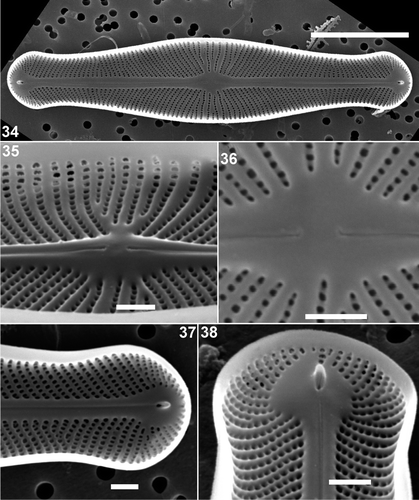
Figs 39–44. Scanning electron micrographs of Envekadea (Navicula) hedinii from the type population of Mapiek Köll. . External valve view of an entire valve. Presence of the hymenes covering the areola openings. . Detail of the central part of the valve showing the central raphe endings. . Detail of an external valve apex with the typical, deflected terminal raphe fissure. . Internal view of an entire valve. Although broken along the axial area, it is still clear that the central raphe endings are weakly deflected. . Detail of the internal structure of a valve apex with the simple helictoglossa. The presence of the raised rims between the striae and the rounded shape of the areolae is well visible. . Detail of a broken valve showing the presence of external hymenes covering the external areola openings. Inside the valve, it is clear that internal hymenes are completely absent. Scale bars: 10 µm () and 5 µm ().
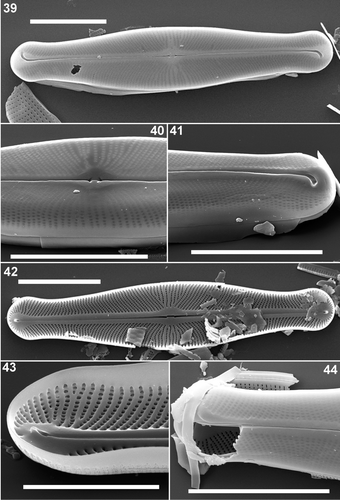
Figs. 45–50. Scanning electron micrographs of Envekadea (Navicula) pseudocrassirostris from Eleusis (Athens, Greece). . External view of an entire valve in a slightly tilted position to show the valve face/mantle margin. Note the sigmoid course of the raphe. . Detail of the external central area with the delta-shaped central raphe pores and the reduced central area. . Detail of an external valve apex with the golfclub-like terminal fissures. The internal raphe branch does not seem to follow the terminal fissure path. . Internal view of an entire valve. . Detail of the girdle. Three unperforated bands can be seen. . Detail of the internal structure of the apex with the simple helictoglossa and the wedge-shaped hyaline area around the terminal ending. Scale bars represent 10 µm () and 1 µm ().
